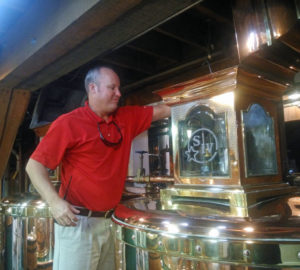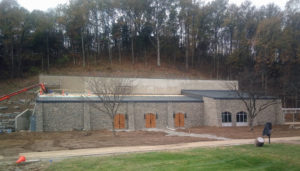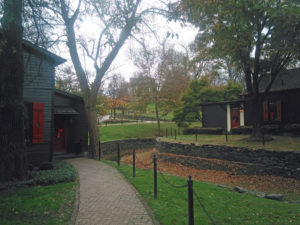By Richard Thomas
When I called on Maker’s Mark on the day after the 2016 Election, it was the first time I had been there in 11 years, and Loretto distillery has seen a lot of changes since then. What at one time was the most visitor-friendly distillery in Kentucky has only become moreso, and the facility showed the signs of not one, but two expansions undertaken since my last visit. They were also nearing completion on a first-of-its-kind bourbon cellar, clawed out of an adjacent hillside to create cave-like aging conditions that best match the conditions needed to make Maker’s 46.
With so much new to see, I was eager to be shown around by Greg Davis, who took up the mantle as Master Distiller at Loretto right in the middle of my 11 year absence. We had a wide ranging conversation during the tour, the best part of which is presented here.
RT: So, you’ve been here as Master Distiller for six years, but in the business for over 25. Tell me about your path coming up.
GD: Aw, I really hate talking about me. Because it’s not about me, it really is about those who taught me. When I was learning, it was before this whole master distiller rock star thing came out, and it bothers me that they don’t get the credit for all the work through all the years of bourbon just being a sin spirit.
So, for me to talk about me is not what I like to do, but I will say this. I had two phenomenal teachers during the course of my career, and now to come and work for the Samuels family is really bringing things full circle.
RT: Who were the two teachers?
GD: First one was Bill Friel. And then one of the most unsung heroes of the bourbon industry out there, Glen Glaser. I started my career with Brown-Forman in R&D, and then moved into production, and I was with Bill at Very Old Barton.
RT: And what did you pick up from Brown-Forman and Barton that is useful at Maker’s?
GD: Well, it’s not about maturation, like it is more here. The focus was always on fermentation and distillation. And one of the things for me was that, as I grew a little bit, Bill said you know the science, and you know there is so much more you don’t understand. By that he meant being with the farmer and getting out into the fields and understanding the cereals themselves. Now I’ve been able to take that to a whole different level at Maker’s Mark, because when we buy our corn from the Mattingly family and our wheat from the Peterson family, and understanding crop year variance, growing conditions, crop plumpness and things like that.
Bill and Glen were very good at maintaining that quality while producing that quantity needed to support the business. Here at Maker’s, we only care about the quality, not the quantity. That is probably why Maker’s has been on allocation since, what, 2008, probably about 2006?
RT: It’s been on allocation for longer than people have been talking about a bourbon boom.
GD: Correct. Now when you take that step back and you focus on quality, and take another step back and focus on it starting from when it comes up out of the ground, that is what I mean by coming full circle.
RT: When you got started, five or six years ago, I know people were calling you “The Baby.” But that is no longer the case, is it?
GD: Well, I got nicknamed The Baby 16 years ago, and the only person in the industry who still calls me that is Jim Rutledge. It was myself, Jim Rutledge, Bill Frill and Jimmy Russell. We were at some bourbon festival and having a good time. Something came up, and I kind of have a warped sense of humor anyway. I forget what it was, but someone said “Oh, you’re just a baby, in fact, that is what you are, the baby.” So I said back “OK Grandpa and Dad, look at your offspring, y’all messed up bad!” So that is all that at that time, I was, I guess I was 30 years old.
RT: Keeping in mind that people still talk about it, though, there has been a generational shift now. You have a lot of people occupying these positions now that are in their 40s or 30s.
GD: That is because nobody was coming up.
RT: Exactly. So how do you feel to be at the front edge of that transition?
GD: Weird. At the festival this year, I was looking at Denny Potter, master distiller over at Heaven Hill, and Denny and I were looking at each other going “Damn, this is weird here, we’re becoming the old farts of the group!” And we busted out laughing at each other.
But when Jimmy retires and Fred goes, it’ll be like “holy crap” for us. But that is a bad thing about the bourbon industry. There is such a slow turnover that your dedication has to be extremely high. People just don’t get that, they don’t get what it takes. Why I’m working weekends, why we’re doing this or doing that. They don’t understand why. It’s just not the way it is.
RT: Or at least that is the way it was, because now the scene has blown up and there are all these new operators out there, looking for people with skills.
GD: Yeah, but I don’t see that as lasting beyond five years. There are too many people out there looking at this [the bourbon boom] as a money-making opportunity, and it’s not. It’s a beverage-making, flavor-making opportunity. That philosophy that their going to make money, capitalize on it and get out, that won’t go far.
RT: What about people like Bardstown Bourbon Company or mid-sized producers like Michter’s?
GD: Oh, they’ll be fine. There is history behind that brand. But it’s the difference between who is really producing and who is just a bottler. And I think they understand that philosophy. Where I see people having a problem are people with a pot still and their operation is the size of this room.
RT: Before we were talking about Maker’s 46 and what happened with Compass Box and their Spice Tree whisky, which ran into regulatory trouble with the Scotch Whisky Association. You mentioned you got some pushback on Maker’s 46. What happened there?
GD: Consumers just didn’t buy it, if you will. Not physically buy it, mind you, but if you try to explain this 46 stave process to consumers, they didn’t get it. It took a long time to get this off the ground.
I can’t say this enough, but through all the bloggers and all the articles, that was a big part of the education how to get out there. But there were people who were saying it’s not a bourbon, it’s not a bourbon. And there were others who were like “Oh my God, this is exactly what I was looking for.” But from a salesman’s or a liquor store owner’s perspective, trying to sell that bottle in 30 or 40 seconds and explain that process as a sound bit, it just wasn’t happening.
RT: When the third expansion came around, something I heard was that you would hit the limit of your ability to draw water. Is that true?
GD: Oh, no. That isn’t a problem.
RT: You’ve been here long enough that most things have your fingerprints on it, and there have been new Maker’s products in that time. But the thing about Maker’s is you basically do the one thing and do it well, so what other permutations might be out there to do? You mentioned a fascination with sherry casks before. Perhaps that?
GD: If I had the capacity, I would want to talk about that, but I don’t have that capacity. We’re already running 24-7. We ran on Christmas Day last year, and we’re talking about running Christmas Day this year. A holiday is just another day around here. One of these days, I might start breaking into that, but right now it’s all about our capacity.
 The Whiskey Reviewer A World of Whiskey, Poured Every Weekday
The Whiskey Reviewer A World of Whiskey, Poured Every Weekday



